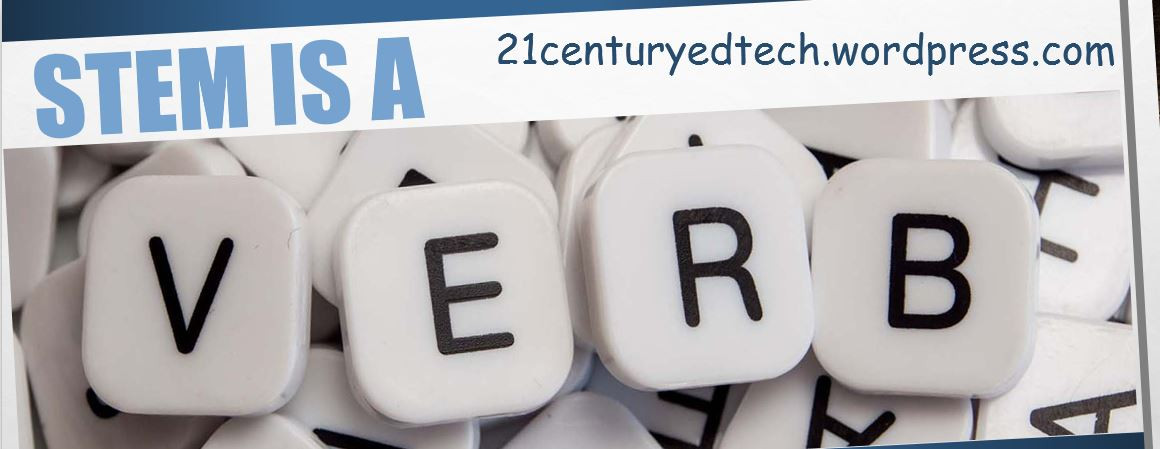Transforming STEM Education from a Noun to a Verb: STEM in all Areas, Part One
STEM action is something all content areas can embrace as they engage students in authentic learning.

Welcome to the first of two articles as I relate the importance of making sure STEM is considered a verb. The first post involves the “why”, and the second post provides 15 ideas for the :how”. There are a lot of definitions in regards to STEM education usually in regards to the nouns including Science, Technology, Engineering, and Math.. As I reflect on my observation of STEM practice in my travels across the country I have become more convinced that STEM is a verb, and not just a set of nouns. In fact, STEM action is something all content areas can embrace as they engage students in authentic learning. I have some great posts coming your way involving PBL and STEM. Most of all, thanks for being one of those 30,000+ visitors a month and over 14,000 subscribers.
“We can have facts without thinking but we cannot have thinking without facts.” – John Dewey
Let’s take a moment and investigate the STEM acronym, after-all it is being used quite a bit across the United States and the world. Often we hear the content areas; Science, Technology, Engineering, and Math as being the basis of STEM. While this is a wonderful collection of nouns that can be used to put together a cross-curricular, transdisciplinary, or project based learning unit of study; it seems to leave out many of the other disciplines through this content definition. By focusing just on these four areas we are losing the powerful and authentic learning opportunities that STEM thinking can bring to the classroom. In fact, we are also leaving some of the most important teachers from other subject areas out of the equation, or the limited definition does not make them feel a part of an exciting possibility! Perhaps that is why we see schools and districts adopting STEAM (infuse the arts), and STREAM (add on some Reading. As we see these new models perhaps we should turn it into STREAMIE (include everyone), from there we can go to STREAMIER and STREAMIEST! Better yet, how about STREAMING… wow… it’s a verb! While the idea could make everyone smile, let’s take a look at what STEM might and could actually look like if we facilitated and promoted and all-inclusive subject area model.
I have often stated that one could look at STEM as the content and PBL as the process, but even in this mode of thinking, it seems to leave out important content. Perhaps it is important to think of STEM as a verb and not a noun. What if all disciplines viewed STEM as a thinking process? This is what many true STEM leaders have been promoting. Yet many programs and initiatives focus on STEM as a noun.It could be due to the many logos we see promoting the four disciplines. John Dewey stated:
“We can have facts without thinking but we cannot have thinking without facts.”
Think for a second of not the stated STEM disciplines, but the skills and thought process it takes to work within a STEM content area. Consider the skills that must be learned for an eventual career, or multiple careers. The action found in the STEM process call allow students to practice and develop the ability to problem solve, authentically learn, think in critical ways, invent, produce, persevere, collaborate, empathize, and design. In doing so, the nouns of STEM work with the important acts of doing and thought. This STEM style thinking opens up a whole new world of possibilities to facts! The facts in the curriculum become real and understandable, opening up a world of real learning to students.
With this mind, it is possible to include all subject areas including language arts, social studies, the fine arts, the practical arts, foreign language, business, plus so much more! Every subject should own STEM thinking! In fact, this style of metacognition becomes even more important as teachers begin to infuse grit and rigor into their lesson plans. Activities that incorporate such thinking build a strong and necessary foundation for project-based learning and transdisciplinary learning. In fact, I ran across a Discovery Education statement that suggested STEM as “Students and Teachers Energizing Minds”. Wow, verbs that allow students to do can be powerful! All of us have to step out of the STEM nouns and find a way to bring the verbs of STEM to every student!
Tools and ideas to transform education. Sign up below.
Join me in the next post as I provide 15 Ideas to Transform STEM Thinking from Nouns To Verbs
cross-posted at 21centuryedtech.wordpress.com
Michael Gorman oversees one-to-one laptop programs and digital professional development for Southwest Allen County Schools near Fort Wayne, Indiana. He is a consultant for Discovery Education, ISTE, My Big Campus, and November Learning and is on the National Faculty for The Buck Institute for Education. His awards include district Teacher of the Year, Indiana STEM Educator of the Year and Microsoft’s 365 Global Education Hero. Read more at 21centuryedtech.wordpress.com.
